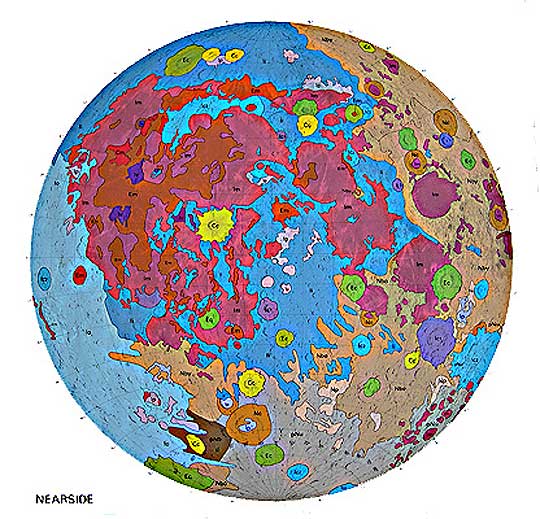Difference between revisions of "February 3, 2015"
(Created page with "__NOTOC__ =Lunar Bible= Originally published February 3, 2004 <table width="640" border="0" align="center" cellpadding="6" cellspacing="2"> <tr> </tr> </table> <table width="...") |
(No difference)
|
Revision as of 00:04, 3 February 2015
Lunar Bible
Originally published February 3, 2004
Image Credit: Geologic Map of the Present Moon, from USGS Prof. Paper 1348 |
|
Lunar Bible Although my collection of lunar books and maps currently includes 211 items, there are only three that I use constantly: Antonin Rukl's Lunar Atlas, Ralph Baldwin's The Face of the Moon and Don Wilhelms' Geologic History of the Moon. The latter, though published in 1987 by the US Geological Survey, is still my lunar bible for it is the best and most thorough geologic description of the Moon. "PP1348" as this book is often called, is a large (11"x14.5") and heavy compilation of the best lunar photos, integrated with a knowing interpretation of lunar sample chemical and radiometric data. Don's presentation is that of a traditional geologist. It is historical or stratigraphic, describing the Moon from the earliest detectable landforms to the most recent. In many ways the summary of the book - and three decades of USGS lunar research - is the Geologic Map of the Present Moon, which is Plate 12A. Unfortunately, this bible is long out of print and not available on the Internet - it should be! Don also published the best insider's story of the scientific side of Apollo: To a Rocky Moon, and this is still available as a paperback. Technical Details: Related Links: Yesterday's LPOD: Brightness at Noon Tomorrow's LPOD: Copernicus! |
|
Author & Editor: |
COMMENTS?
Register, Log in, and join in the comments.




